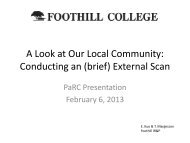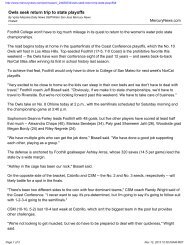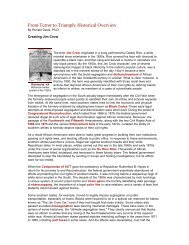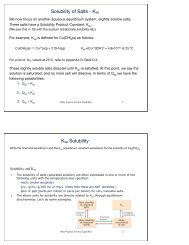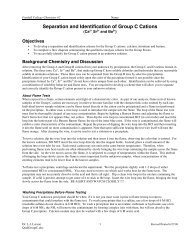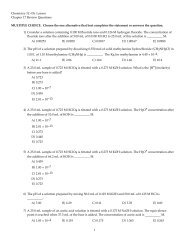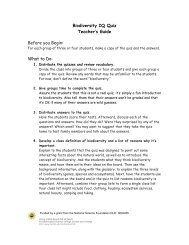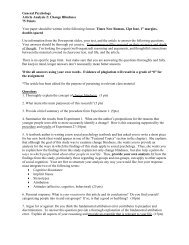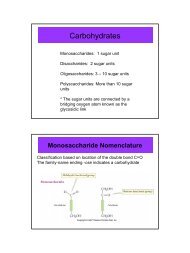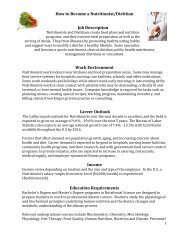1.1 Chemistry: The Central Science
1.1 Chemistry: The Central Science
1.1 Chemistry: The Central Science
You also want an ePaper? Increase the reach of your titles
YUMPU automatically turns print PDFs into web optimized ePapers that Google loves.
<strong>1.1</strong> <strong>Chemistry</strong>: <strong>The</strong> <strong>Central</strong> <strong>Science</strong><br />
Property—A characteristic useful for identifying a<br />
substance or object. <strong>The</strong>se include size, color, and<br />
temperature, as well as chemical composition and<br />
chemical reactivity.<br />
Physical Change—A change<br />
that does not affect the<br />
chemical makeup of a<br />
substance or object.<br />
Chemical Change—A change<br />
in the chemical makeup of<br />
a substance.
1.2 States of Matter<br />
Matter exists in three forms:<br />
• Solid— A substance that has a definite shape and<br />
volume.<br />
• Liquid— A substance that has a definite volume<br />
but assumes the shape of its container.<br />
• Gas— A substance that has neither a definite<br />
volume nor a definite shape.
1.2 States of Matter<br />
Many substances can exist in all three phases,<br />
and participate in changes of state.
1.3 Classification of Matter<br />
Substances are classified as pure substances or<br />
mixtures.<br />
• Pure substance—A substance that has a uniform<br />
chemical composition throughout.<br />
• Mixture—A blend of two or more substances,<br />
each of which retains its chemical identity.<br />
• Homogeneous mixture—A uniform mixture that has<br />
the same composition throughout.<br />
• Heterogeneous mixture—A non-uniform mixture that<br />
has regions of different composition.
1.3 Classification of Matter<br />
Components of a mixture can be separated<br />
without changing their identities.<br />
Pure substances can be classified into two<br />
groups:<br />
• Element—A fundamental substance that cannot<br />
be broken down chemically into any simpler<br />
substance.<br />
• Chemical compound—A pure substance that can<br />
be broken down into simpler substances by<br />
chemical reactions.
1.3 Classification of Matter<br />
Water can be chemically changed by passing an<br />
electric current through it to produce<br />
hydrogen and oxygen.<br />
• <strong>The</strong> reactant (water) is written on the left.<br />
• <strong>The</strong> products (hydrogen and oxygen) are written<br />
on the right.<br />
• An arrow connects the two parts to indicate a<br />
chemical reaction. <strong>The</strong> conditions necessary are<br />
written above and below the arrow.
1.4 Chemical Elements and Symbols<br />
• 118 elements have been identified. 91 occur<br />
naturally.<br />
• A one- or two-letter shorthand is used for<br />
each element.<br />
– <strong>The</strong> first letter is always capitalized.<br />
– <strong>The</strong> second letter, if any, is always lowercase.<br />
• Most of the symbols are based on the<br />
elements commonly used names.<br />
• A few symbols are based on Latin names for<br />
the elements.
1.4 Chemical Elements and Symbols<br />
Not all elements occur with equal abundance.
1.4 Chemical Elements and Symbols<br />
• <strong>The</strong> symbols of elements are combined to form<br />
chemical formulas.<br />
• Subscripts show how many atoms (the smallest<br />
fundamental units) of each element are in a given<br />
chemical compound.
1.5 Elements and the Periodic Table<br />
<strong>The</strong> periodic table, divided into metals, nonmetals, and metalloids.
1.6 Chemical Reactions: An Example of Chemical Change<br />
<strong>The</strong> reaction of nickel with hydrochloric acid can be<br />
either written in words or a shorthand notation using<br />
symbols to represent the elements or compounds<br />
involved as reactants and products.
1.7 Physical Quantities<br />
Mass, volume, temperature, density, and other<br />
physical properties are called physical<br />
quantities and are described by both a<br />
number and a unit:<br />
• Physical quantity—A physical property that<br />
can be measured.<br />
• Unit—A defined quantity used as a standard<br />
of measurement.
1.7 Physical Quantities<br />
Scientists have agreed on the Système<br />
International d’Unites (International System of<br />
Units), abbreviated SI.<br />
• Mass is measured in kilograms (kg).<br />
• Length is measured in meters (m).<br />
• Volume is measured in cubic meters (m 3 ).<br />
• Temperature is measured in kelvins (K).<br />
• Time is measured in seconds (s).
1.7 Physical Quantities
1.7 Physical Quantities
1.8 Measuring Mass, Length, and Volume<br />
• Mass—A measure of the amount of matter in<br />
an object.<br />
• Weight—A measure of the gravitational force<br />
that the earth or other large body exerts on an<br />
object.<br />
• <strong>The</strong> mass of an object can be determined by<br />
comparing the weight of the object to the<br />
weight of a known reference standard.
1.8 Measuring Mass, Length, and Volume<br />
• <strong>The</strong> meter is the standard measure of length,<br />
or distance, in the SI and metric systems.<br />
• Volume is the amount of space occupied by an<br />
object. <strong>The</strong> SI unit for volume—the cubic<br />
meter, m 3 —is so large that the liter (1 L =<br />
0.001 m 3 = 1 dm 3 ) is much more commonly<br />
used.
1.9 Measurement and Significant Figures<br />
• Every experimental<br />
measurement has a degree<br />
of uncertainty.<br />
• <strong>The</strong> value recorded should<br />
use all the digits known<br />
with certainty, plus one<br />
estimated digit.<br />
• Significant figures—<strong>The</strong><br />
number of meaningful<br />
digits used to express a<br />
value.
1.9 Measurement and Significant Figures<br />
Rules for Significant Figures<br />
Rule 1: Zeros in the middle of a number are like any other<br />
digit; they are always significant.<br />
Rule 2: Zeros at the beginning of a number are not<br />
significant; they act only to locate the decimal point.<br />
Rule 3: Zeros at the end of a number and after the decimal<br />
point are significant. It is assumed that these zeros would<br />
not be shown unless they were significant.<br />
Rule 4: Zeros at the end of a number and before an implied<br />
decimal point may or may not be significant.
1.9 Measurement and Significant Figures<br />
Some numbers are exact and effectively have an<br />
unlimited number of significant figures.<br />
• A class might have exactly 32 students (not<br />
31.9, 32.0, or 32.1).<br />
• 1 foot is defined to have exactly 12 inches.
<strong>1.1</strong>0 Scientific Notation<br />
• Scientific notation—A number expressed as<br />
the product of a number between 1 and 10,<br />
times 10 raised to a power.<br />
215 = 2.15 × 100 = 2.15 × (10 × 10) = 2.15 × 10 2<br />
• <strong>The</strong> exponent on the 10 tells how many places<br />
the decimal point was moved to position it<br />
just after the first digit
<strong>1.1</strong>0 Scientific Notation<br />
• To express a number smaller than 1 in<br />
scientific notation, the decimal point is moved<br />
to the right until it follows the first digit. <strong>The</strong><br />
number of places moved is the negative<br />
exponent of 10.
<strong>1.1</strong>0 Scientific Notation<br />
• To convert a number written in scientific<br />
notation to standard notation, the process is<br />
reversed.<br />
– positive exponent—<strong>The</strong> decimal point is moved to<br />
the right a number of places equal to the<br />
exponent.<br />
– negative exponent—<strong>The</strong> decimal point is moved<br />
to the left a number of places equal to the<br />
exponent.<br />
• Only significant numbers are used.
<strong>1.1</strong>1 Rounding Off Numbers<br />
Calculators often display more digits than are<br />
justified by the precision of the data.<br />
Rounding off—A procedure used for deleting<br />
nonsignificant figures<br />
• Rule 1: In carrying out multiplication or division,<br />
the answer cannot have more significant figures<br />
than the original numbers.<br />
• Rule 2: In carrying out addition or subtraction,<br />
the answer cannot have more digits after the<br />
decimal point than the original numbers.
<strong>1.1</strong>2 Problem Solving: Unit Conversions and<br />
Estimating Answers<br />
<strong>The</strong> simplest way to carry out calculations<br />
involving different units is to use the factorlabel<br />
method.<br />
• <strong>The</strong> factor-label method is a problem-solving<br />
procedure in which equations are set up so<br />
that unwanted units cancel and only the<br />
desired units remain.<br />
• <strong>The</strong> conversion factor is an expression of the<br />
numerical relationship between two units.
<strong>1.1</strong>2 Problem Solving: Unit Conversions and<br />
Estimating Answers<br />
• Conversion factors are numerically equal to one.<br />
• Units are treated like numbers and can thus be<br />
multiplied and divided.<br />
• Set up an equation so that all unwanted units cancel.<br />
• Think through a rough estimate, or ballpark estimate,<br />
as a check on your work.
<strong>1.1</strong>2 Problem Solving: Unit Conversions and<br />
Estimating Answers<br />
• STEP 1: Identify the information given, including units.<br />
• STEP 2: Identify the information needed in the answer,<br />
including units.<br />
• STEP 3: Find the relationship(s) between the known<br />
information and unknown answer, and plan a series of<br />
steps, for getting from one to the other.<br />
• STEP 4: Solve the problem.<br />
• BALLPARK CHECK—Make a ballpark estimate at the<br />
beginning and check it against your final answer to be<br />
sure the value and the units of your calculated answer<br />
are reasonable.
<strong>1.1</strong>3 Temperature, Heat, and Energy<br />
• Energy—<strong>The</strong> capacity to do work or supply<br />
heat.<br />
• Temperature—<strong>The</strong> measure of the amount of<br />
heat energy in an object. Commonly reported<br />
either in Fahrenheit (°F) or Celsius (°C) units,<br />
but the SI unit for temperature is the kelvin<br />
(K). (Note that we say only “kelvin,” not<br />
“degrees kelvin.”)
<strong>1.1</strong>3 Temperature, Heat, and Energy<br />
• <strong>The</strong> kelvin and the Celsius degree are the<br />
same size.<br />
• Thus, a change in temperature of 1 °C is equal<br />
to a change of 1 K.<br />
• <strong>The</strong> Celsius scale assigns a value of 0 °C to the<br />
freezing point of water.<br />
• <strong>The</strong> Kelvin scale assigns a value of 0 K to the<br />
coldest possible temperature, absolute zero,<br />
which is equal to 273.15 C. Thus, 0 K =<br />
273.15 C, and +273.15 K = 0 C.
<strong>1.1</strong>3 Temperature, Heat, and Energy<br />
• <strong>The</strong> Fahrenheit scale defines the freezing<br />
point of water as 32 °F and the boiling point of<br />
water as 212 °F.<br />
• It takes 180 Fahrenheit degrees to cover the<br />
same range encompassed by 100 Celsius<br />
degrees.<br />
• A change in temperature of 1.0 °C is equal to a<br />
change of 1.8 °F.
<strong>1.1</strong>3 Temperature, Heat, and Energy<br />
Temperature conversions:<br />
K = °C + 273.15<br />
°C = K – 273.15<br />
F <br />
C <br />
9 F<br />
5 C C<br />
<br />
32 F<br />
<br />
5 C<br />
9 F<br />
F 32 F
<strong>1.1</strong>4 Density and Specific Gravity<br />
• Density is the physical property that relates the mass<br />
of an object to its volume; mass per unit volume.<br />
• Most substances contract when cooled, and expand<br />
when heated.<br />
• Water expands when it freezes, so ice floats on liquid<br />
water.




